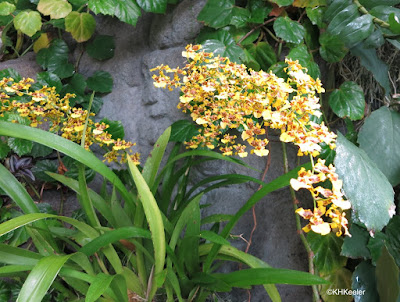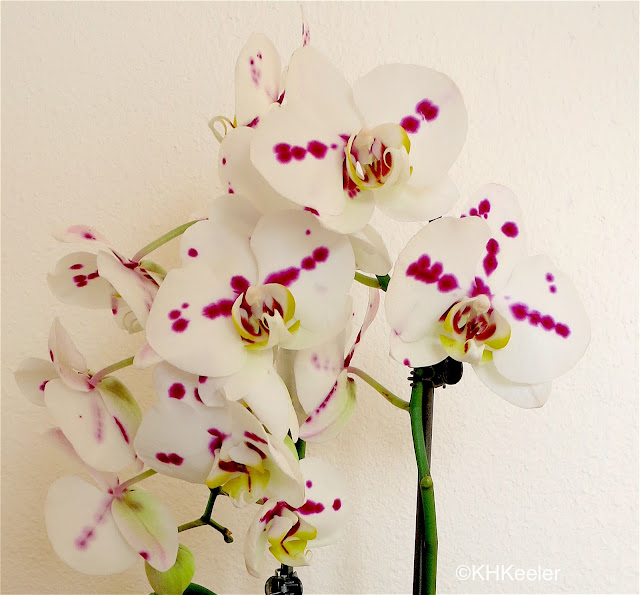The new orchid sat on the table, long sprays of flowers with big white petals with purple spots bending in a graceful arc above large green leaves.
"The natives in this house indicate that you write about plants, but that you have written very little about orchids" it said to me.
"That's right,"I admitted.
"Consider, we are the largest of the plant families. Out of 452 vascular plant families, orchids are #1 with the most species...at least 26,000. "
"True," I replied, defensively, "but you aren't first in number of genera or abundance. There are many more genera in the Asteraceae (daisy family). The grasses, Poaceae, are much more common, forming vast grasslands. Pines, Pinaceae, may have the greatest biomass of any vascular plant family."
You could see the annoyance in the quiver of petals "Orchids are NOT common. Finding an orchid in nature gives hikers a thrill. Finding a grass or a daisy, paugh! No one would dream of treating orchids as they do crabgrass or dandelions.
"Being rare like an orchid is an art. Some plants are rare because they can only grow on some God-forsaken hilltop. While a few orchids are like that--we are after all a huge, world-wide family and will naturally have some less-exaulted members--most are epiphytes growing on trees, widely dispersed in the forest. When plants are scattered, animals may fail to find a second plant and so will not pollinate. Yet we orchids, with individuals far, far apart, have prospered and diversified.
"We have perfected the art of attracting pollinators across long distances. Our fragrances will bring bees eager for pollen or nectar or oil a mile across a dense forest. So enchanted are they that they continue on to find another plant and another, though the distances are great."
"Or you deceive the pollinator, pretending to be a female bee, for example," I said.
The orchid quivered. "Not all of my 26,000 relatives are honest. Are yours?
"But," it added after a moment, "some of the scams of orchids are very sophisticated and elegant, so artistic." (examples BBC Brooklyn Botanic Garden)
"I'll concede that," I said. "I've never seen one of the bee-imitating orchids, and would love to." (images)
"We are diverse, with all manner of shapes and colors. Humans have loved us for centuries, crossing plants that would never have met in nature, to produce other colors and shapes. Indeed, there are thousands of orchid collectors--we like to think of them as orchid groupies. There's a huge international trade, fantastic shows--look at the American Orchid Society calendar link!--and a black market, all for orchids.
"Indeed, you were given me as a thank you gift. Compared to receiving an orchid, who would choose a grass or or a dandelion or a bean?"
"That's a little harsh; chrysanthemums and roses make lovely gifts."
"For those who lack the vision to choose an orchid, possibly Here are photos of just a few of my relatives. You decide!"
"See," the orchid chortled, "you had a terrible time not including additonal photos of quite different orchids. Everyone with any sense knows we are incomparable!"
Comments and corrections welcome.
Top ten plant families: Name, number of species, number of genera (numbers from Angiosperm Phylogeny website)
Orchidaceae 26,000 800
Asteraceae (daisies, sunflowers, dandelion) 25040 1,620
Fabaceae (peas, beans) 19,580 766
Rubiaceae (coffee, bedstraw) 13,235 614
Poaceae (grasses) 11,337 707
Lamiaceae (mints, salvias) 7,280 236
Euphorbiaceae (spurges, poinsettia) 6,745 218
Myrtaceae (myrtle, clove, guava) 5,900 131
Cyperaceae (sedges) 5,695 98
Melastomaceae (deergrass, pearl flower, largely tropical) 4,900 188
The orchid I was given is classified as a moth orchid Phalaenopsis by humans, probably Phalaenopsis amabilis. (link) At my house it is "The Orchid." I don't know what it calls itself.
Kathy Keeler, A Wandering Botanist
More at awanderingbotanist.com












So interesting, fun read
ReplyDelete